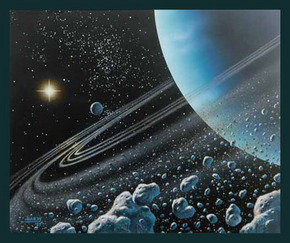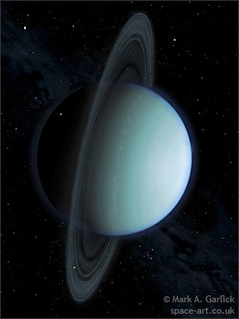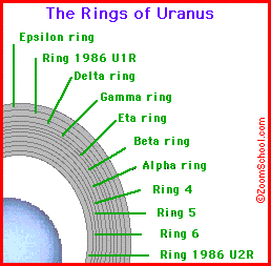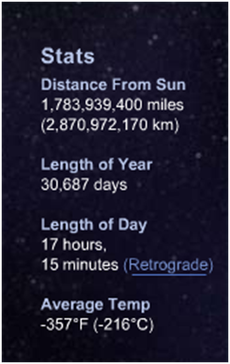Our Solar System
Planet Uranus

Uranus is blue-green in color, the result of methane in its mostly hydrogen-helium atmosphere. The planet is often dubbed an ice giant, since 80 percent or more of its mass is made up of a fluid mix of water, methane, and ammonia ices.
Unlike the other planets of the solar system, Uranus is tilted so far that it essentially orbits the sun on its side, with the axis of its spin nearly pointing at the star. This unusual orientation might be due to a collision with a planet-sized body soon after it was formed.
This unusual tilt gives rise to extreme seasons roughly 20 years long, meaning that for nearly a quarter of the Uranian year, equal to 84 Earth years, the sun shines directly over each pole, leaving the other half of the planet to experience a long, dark, cold winter.
A planet's magnetic poles are typically lined up with the poles along which it rotates, but Uranus' magnetic field is tilted, with its magnetic axis tipped over nearly 60 degrees from the planet's axis of rotation. This leads to a strangely lopsided magnetic field for Uranus, with the strength of the field at the northern hemisphere's surface being up to more than 10 times that of the strength at the southern hemisphere's surface.
Unlike the other planets of the solar system, Uranus is tilted so far that it essentially orbits the sun on its side, with the axis of its spin nearly pointing at the star. This unusual orientation might be due to a collision with a planet-sized body soon after it was formed.
This unusual tilt gives rise to extreme seasons roughly 20 years long, meaning that for nearly a quarter of the Uranian year, equal to 84 Earth years, the sun shines directly over each pole, leaving the other half of the planet to experience a long, dark, cold winter.
A planet's magnetic poles are typically lined up with the poles along which it rotates, but Uranus' magnetic field is tilted, with its magnetic axis tipped over nearly 60 degrees from the planet's axis of rotation. This leads to a strangely lopsided magnetic field for Uranus, with the strength of the field at the northern hemisphere's surface being up to more than 10 times that of the strength at the southern hemisphere's surface.
The Sideways Planet

Uranus is different from any other planet in the Solar System in that its axis of rotation is tilted 98 degrees. It is nearly parallel to the ecliptic. Uranus appears to be tipped on its side. This has some interesting effects on the planet. The Sun shines alternately on the poles and equatorial regions of the planet rather than constantly shining on its equatorial regions, as on Earth. Astronomers are not sure what accounts for this strange position. One theory suggests that a massive collision with another planet-sized body may have knocked Uranus on its side. This collision is believed to have taken place very early in the Solar System's history. Another strange fact about Uranus is that its magnetic field is tilted at a 60-degree angle to its axis of rotation. This angle is only 12 degrees on Earth. An interesting effect of Uranus' sideways tilt is that the tail of the planet's magnetic field is twisted like a corkscrew.
Uranus Rings

Uranus has a belt of 11 faint, narrow rings composed of rock and dust. They circle Uranus is very elliptical orbits. These rings are only a fraction of the size of Saturn's rings, and were only discovered in 1977.

